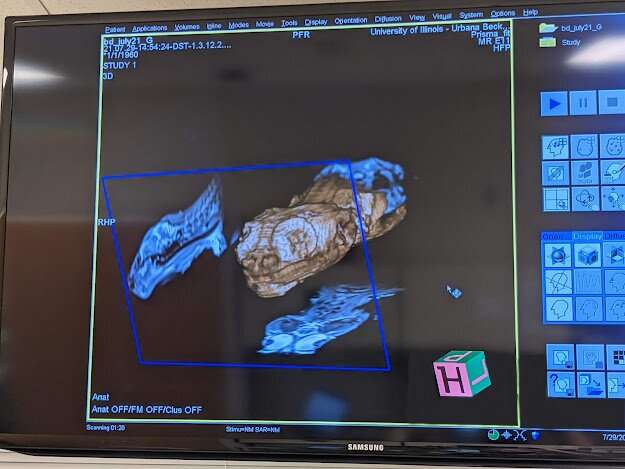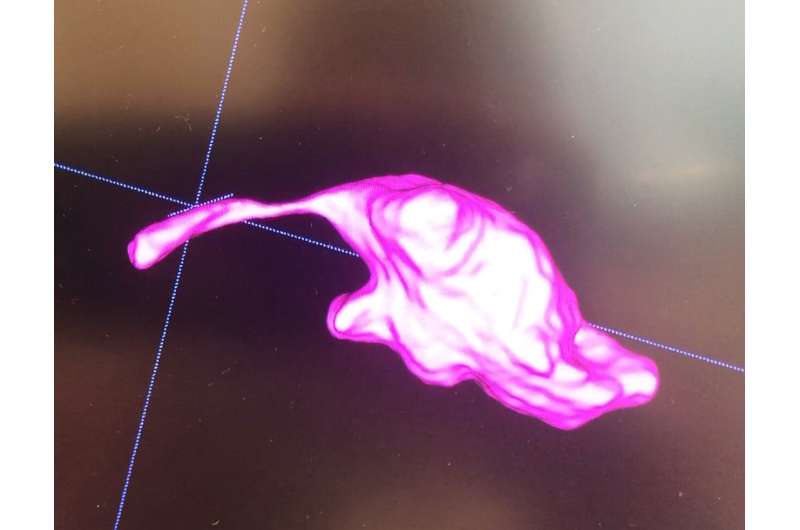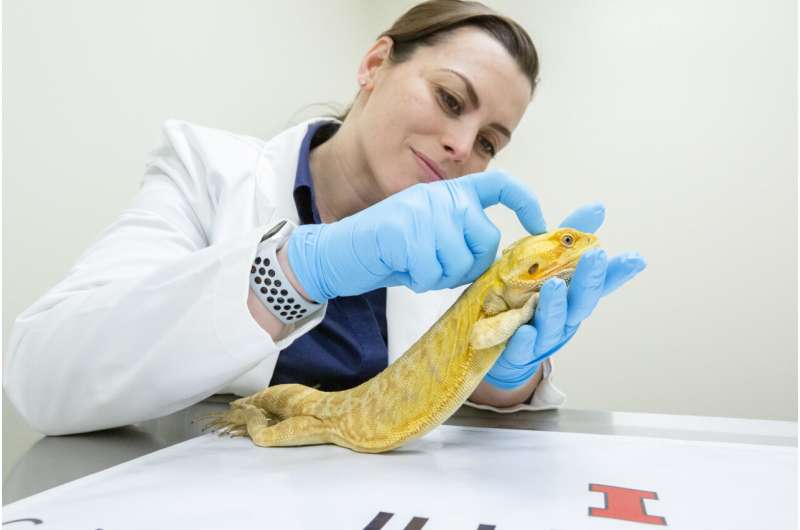Interdisciplinary researchers at the University of Illinois Urbana-Champaign performed MRI scans on bearded dragons, like the one shown here, to generate a first-of-its-kind brain atlas: a high-resolution map of regions in the creatures' brains. Credit: Beckman Institute for Advanced Science and Technology.
They're not too cuddly, but bearded dragons are working their way into the hearts and homes of American families. And now, researchers at the University of Illinois Urbana-Champaign are ensuring that these scaly companion animals receive the same medical care as Fluffy, Stripes, and Snowball.
Interdisciplinary researchers at the Beckman Institute for Advanced Science and Technology and the College of Veterinary Medicine performed MRI scans on bearded dragons to generate a first-of-its-kind brain atlas: a high-resolution map of regions in the creatures' brains.
Currently, there no standardized protocol for performing MRIs on America's No. 1 companion reptile.
"It is challenging to get spatial resolution sufficient to see disease in the brain of a bearded dragon using a clinical MRI machine designed for humans," said Brad Sutton, a professor of bioengineering and the technical director of the Biomedical Imaging Center at the Beckman Institute. "It is important to understand what a healthy bearded dragon's brain looks like, and to understand the variation across different animals."
Bearded dragons are America's No. 1 companion lizard. Dr. Krista Keller and "B" the bearded dragon discuss why they are creating an MRI brain atlas for these amazing reptiles. Keller is an assistant professor in the Department of Veterinary Clinical Medicine at the University of Illinois Urbana-Champaign. "B" is a bearded dragon with swag. Credit: Beckman Institute for Advanced Science and Technology.
Anesthesia is routinely used for animals during MRI scans. Because the scanner contains a strong magnet, specialized metal-free anesthetic monitoring equipment is also required.
"There are several instances when a bearded dragon would benefit from an MRI exam. However, a strong consideration prior to ordering this diagnostic would be the risks associated with anesthesia," said Krista Keller, an assistant professor of veterinary and clinical medicine and the service head of zoological medicine at the Veterinary Teaching Hospital.
Interdisciplinary researchers at the University of Illinois Urbana-Champaign performed MRI scans on bearded dragons, like the one shown above, to generate a first-of-its-kind brain atlas: a high-resolution map of regions in the creatures' brains.This image depicts a bearded dragon mid-sagittal slice and was generated using a 3 Tesla MRI scanner located in the Biomedical Imaging Center at the Beckman Institute for Advanced Science and Technology. The bearded dragon is facing left, with the top of its head corresponding to the top of the image. Credit: Beckman Institute for Advanced Science and Technology.
The researchers' work appeared in Frontiers in Veterinary Science. It identified a predictable and safe anesthetic protocol that can be used in future clinical cases. Data from this study also expands the clinical information available to researchers performing high-resolution MRI scans of bearded dragons in the future.
To compile their data, the team used a 3 Tesla MRI scanner located in Beckman's Biomedical Imaging Center to image seven bearded dragons safely and non-invasively. The bearded dragons came from a research and study colony and represent the most common lizard species encountered in veterinary medical practice.
The researchers used an image averaging strategy to compile the scans into a single idealized model of a bearded dragon brain; the resulting atlas will be used as a standard reference material in the event that a bearded dragon may be diagnosed with or treated for a neurological disease. Anatomical atlases of reptiles including the tawny dragon, the tokay gecko, and the garter snake were also used for reference.
While bearded dragons could certainly benefit from MRI exams, the risks associated with anesthesia are significant, according to assistant professor of veterinary clinical medicine Krista Keller (pictured with a bearded dragon at the University of Illinois Urbana-Champaign College of Veterinary Medicine). Photo courtesy of L. Brian Stauffer. Credit: L. Brian Stauffer.
"Our goal for this study was to not only provide clinicians with an anatomic reference of the bearded dragon brain, but to also establish a safe and efficient MRI and sedation protocol that can be utilized in practices with access to either a 1.5 or 3 Tesla MRI," said Kari Foss, an assistant professor of veterinary and clinical medicine.
The researchers identified nine anatomic structures in the bearded dragon brain including the thalamus, optic nerve, optic tectum, lateral ventricles, medulla, telencephalon, tectal ventricle, cerebellum, and the olfactory lobe and stalk.
More information: Kari D. Foss et al, Establishing an MRI-Based Protocol and Atlas of the Bearded Dragon (Pogona vitticeps) Brain, Frontiers in Veterinary Science (2022). DOI: 10.3389/fvets.2022.886333


























